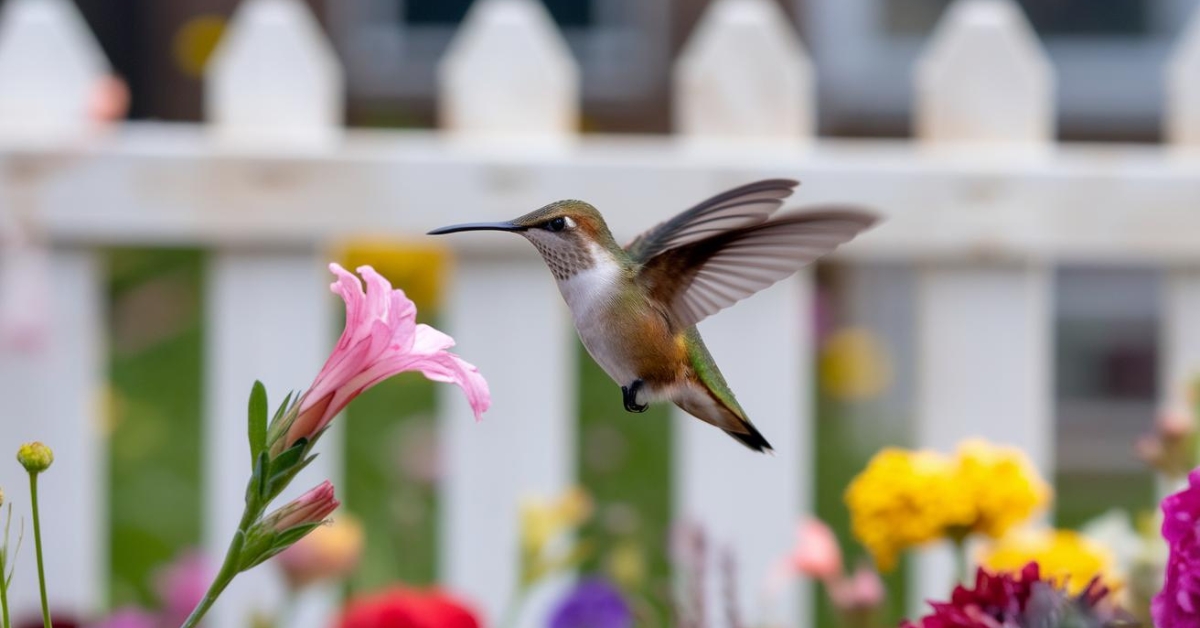Hummingbirds typically begin migrating from Ohio between late August and the end of October. The decreasing daylight hours trigger a hormonal change in the birds, signalling them to increase their food intake to store energy for their journey.
As winter approaches and temperatures drop, hummingbirds leave Ohio for warmer climates, usually Central and South America.
It is essential to leave these nectar-bird feeders up until a few weeks after the last sighting to aid those birds that are still in transit.
Related post to read: 7 Different Types Of Hummingbirds Found In Ohio.
In this blog post, we will explore some of the common questions and facts surrounding hummingbirds’ yearly migration. These are questions such as;
- The factors that trigger these nectar-birds to start their migration from Ohio,
- The signs that indicate they are preparing to leave,
- Outline the typical route they follow,
- Explore how you can assist these amazing creatures in their journey and much more.
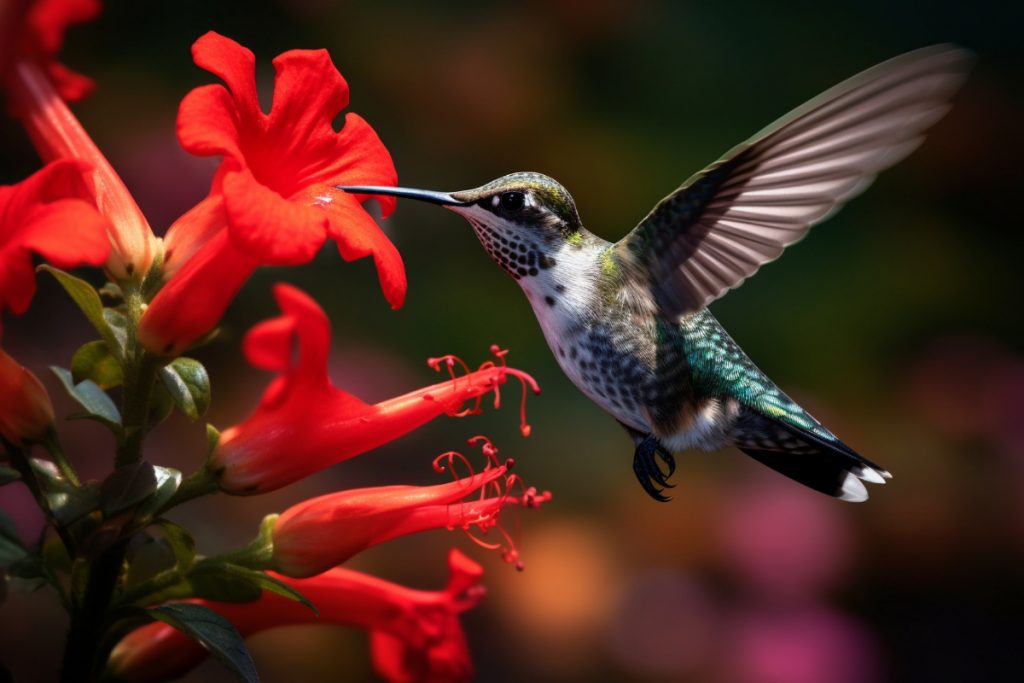
4 Key Takeaways
- Hummers typically begin migrating from Ohio between late August and the end of October, triggered by decreasing daylight hours and falling temperatures.
- Their migration route generally takes them south through the Central United States, crossing the Gulf of Mexico, and into Central and South America.
- To make your yard attractive to these nectar-loving birds before they leave Ohio, set up hummingbird feeders and provide perching spaces near the feeders.
- After hummers leave Ohio, it is best to clean and store feeders in a cool, dry place until their anticipated return between mid-April and early May the following year.
What Triggers Their Migration?
Hummingbirds are sensitive to changes in daylight, which act as a signal for them to begin their migration. As the days get shorter in late summer and early autumn:
- The decrease in daylight hours triggers a hormonal change in hummingbirds.
- This hormonal change prompts them to increase their food intake to store fat, which will fuel their long journey.
- As winter approaches, the drop in temperature plays a secondary role, encouraging hummingbirds to head south in search of warmer climates.
The Signs of Pre-migration Preparation
Watch for these signs:
- Increased Feeding: Before they leave, hummingbirds consume up to twice their body weight in food every day. This helps them store fat, which is crucial for their migration.
- Changes in Behaviour: As the time to migrate approaches, hummingbirds become more territorial around food sources. You may notice more aggressive interactions between them as they stock up on energy for the journey.
The Journey: Routes and Challenges
Hummingbirds from Ohio typically migrate to Central America, crossing the Gulf of Mexico in a single, daunting flight. This journey includes:
- A non-stop flight of up to 18 hours across the Gulf, covering about 500 miles without resting.
- Navigation through harsh weather conditions and avoiding predators are significant challenges during this journey.
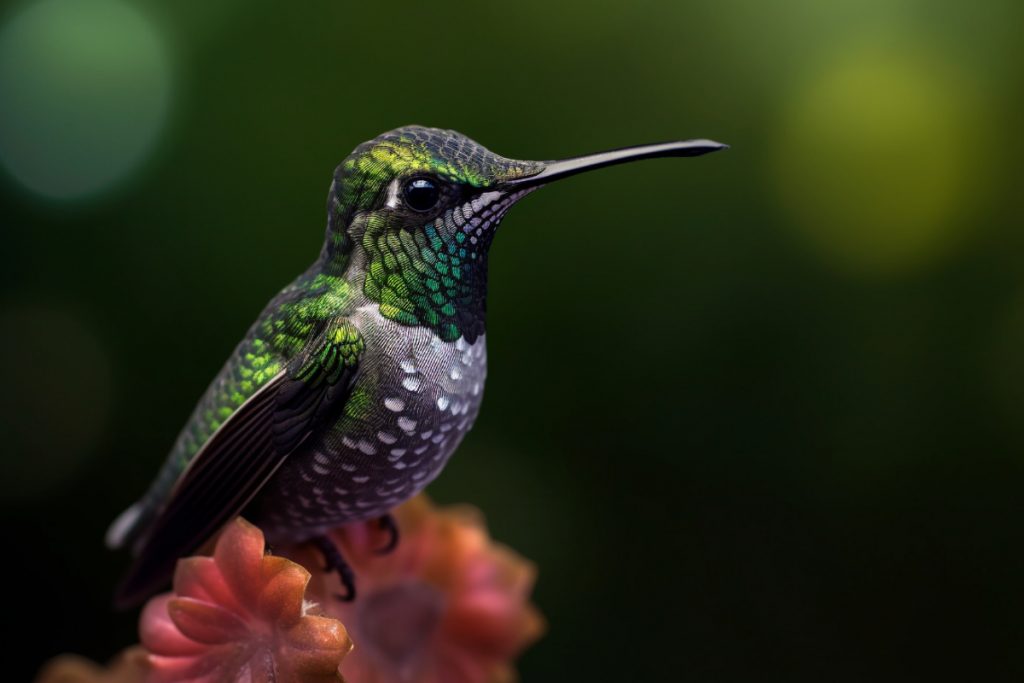
How Long Does the Migration Journey Typically Take for Hummingbirds Leaving Ohio?
The migration journey for hummingbirds leaving Ohio can vary, but it typically takes about two to three weeks. They travel at an average speed of 25 to 30 miles per hour, covering distances of up to 3,000 miles in total.
This pace allows them to rest and refuel along the way, finding nectar-rich flowers and feeders en route to their winter destinations.
How Can I Make My Yard More Attractive to Hummingbirds Before They Leave Ohio?
To make your yard attractive to hummingbirds before they leave Ohio:
- Set up hummingbird feeders with a solution of four parts water to one part white sugar, avoiding red dye.
- Provide perching spaces near feeders and flowers, as hummingbirds often rest between feedings.
- Ensure a clean water source is available for them to drink and bathe.
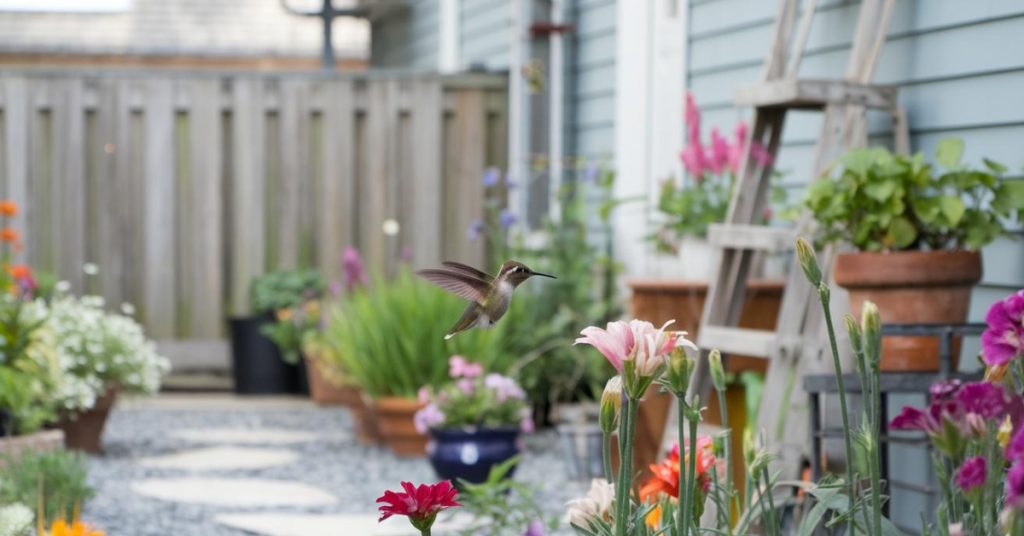
What Should You Do with Your Feeders When They Leave Ohio?
After hummingbirds leave Ohio, clean your feeders thoroughly with a cleaning solution such as vinegar and water or any other safe cleaning solution.
If you decide to use vinegar, one of the common mixtures to use is 4 parts hot water to 1 part vinegar. Rinse well and allow them to dry completely.
After you have thoroughly cleaned the feeder, store your feeders in a cool and dry place until the hummingbirds return in spring.
Basically, this prevents mould growth and keeps the feeders ready for the next season.
Are There Any Risks or Dangers that Hummers Face During Their Migration from Ohio?
During their migration from Ohio, hummers face several risks and dangers:
- Predation by birds of prey, cats, and other predators.
- Harsh weather conditions, including storms and cold fronts.
- Exhaustion and starvation if they cannot find sufficient food sources along their route.
- Loss of habitat due to human activities, which reduces their feeding and resting places.
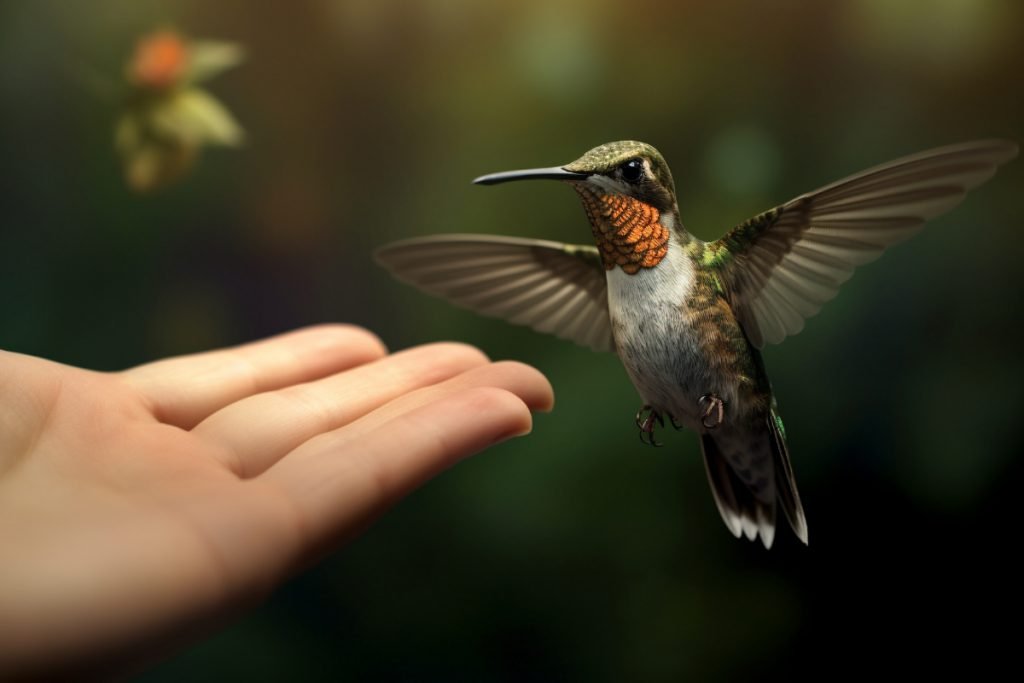
When Do Hummingbirds Typically Return to Ohio After Their Winter Migration?
Hummingbirds typically return to Ohio between mid-April and early May. Their return is triggered by increasing daylight hours and rising temperatures, signalling the availability of food sources in Ohio.
In most cases, hummingbird watchers often prepare for their arrival by setting up clean, fresh feeders to welcome them back.
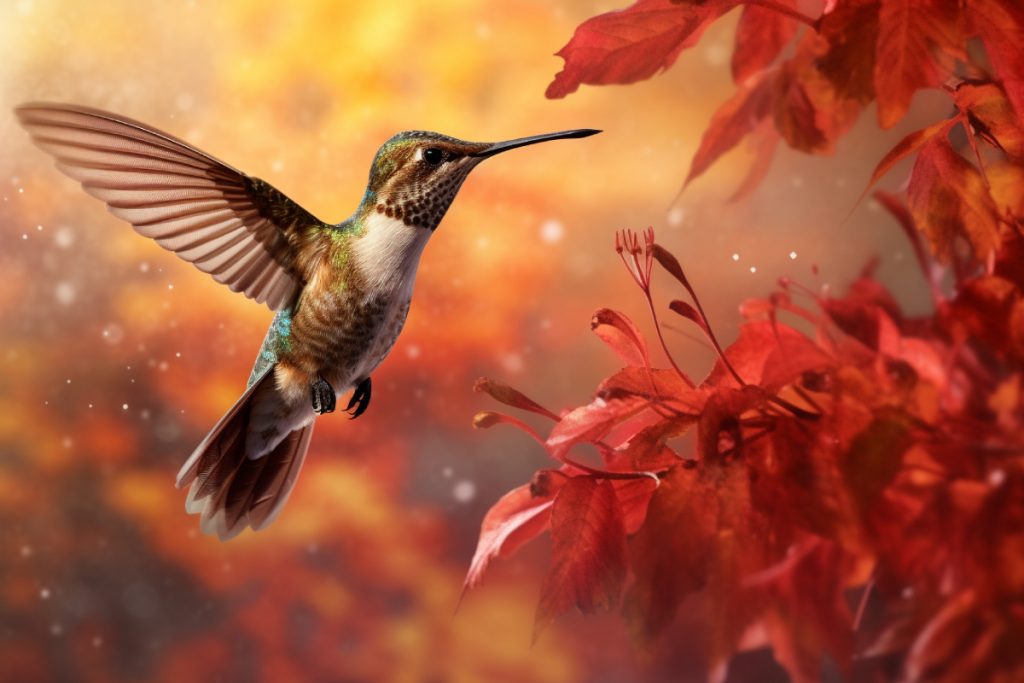
Final Thoughts
As the golden hues of autumn paint the landscapes of Ohio, a part of us can’t help but feel a tinge of melancholy as we bid farewell to our delicate, fluttering friends – the hummingbirds.
It’s a poignant reminder of the transient, cyclical nature of life that these vibrant creatures, which added a dash of magic to our summer gardens, must now embark on their epic journey south.
As we watch the last of them take to the skies, leaving our Ohio homes a little quieter and a little less colourful, we’re reminded of the resilience and tenacity encapsulated in such tiny, fragile beings.
As you stand in your garden, perhaps beside the now still and waiting feeder, consider this: in a world that is increasingly fast-paced and disconnected, what lessons can we take from the humble hummingbird’s annual voyage?
Can their instinctual connection to the Earth inspire us to foster our own bond with nature, to live more harmoniously with the changing seasons, as they do?
It’s a thought worth pondering until the day our gardens hum with their presence once more.
Frequently Asked Questions (FAQs)
Q: What common species of hummingbird is typically found in Ohio during the summer months?
A: The ruby-throated hummingbird (Archilochus colubris) is the most common species found in Ohio during the summer.
Q: Are there other species of hummingbirds that visit Ohio aside from the ruby-throated hummingbird?
A: While the ruby-throated hummingbird is the most common, occasionally, bird watchers might spot rufous hummingbirds or Black-Chinned Hummingbirds in Ohio.
Q: When do hummingbirds typically begin their annual migration from Ohio?
A: Hummingbirds typically begin their migration from Ohio between late August and the end of October.
Q: What triggers the Hummingbird migration in Ohio?
A: Decreasing daylight hours and falling temperatures are primary triggers for their migration.
Q: How can one attract hummingbirds to their garden in Ohio?
A: Planting native, nectar-rich flowers, setting up nectar feeders, and providing a clean water source can attract hummingbirds.
Q: What is the main source of nectar for hummingbirds in Ohio gardens?
A: Native flowers and sugar solutions in nectar feeders serve as primary sources of nectar for hummingbirds.
Q: When do hummingbirds return to Ohio after their winter migration?
A: Hummingbirds generally return to Ohio between mid-April and early May.
Q: What is the significance of bright colours for hummingbirds?
A: Bright colours, especially reds, attract these nectar-loving birds as potential sources of food.
Q: How can one identify a ruby-throated hummingbird?
A: The ruby-throated hummingbird, or Archilochus colubris, can be identified by its bright ruby-red throat and often a white patch below it.
Q: Are there specific areas in Ohio where hummingbirds are more prevalent?
A: Hummingbirds can be found throughout Ohio, but areas with plenty of food sources, like gardens with native flowers and feeders, might attract higher numbers.
Q: When do hummingbirds leave central Ohio?
A: Hummingbirds typically begin migrating from central Ohio between late August and the end of October, similar to other parts of the state.
Q: Is the migration pattern different for hummingbirds in Cleveland, Cincinnati, or other parts of Ohio?
A: The migration pattern is generally consistent across Ohio, including Cleveland and Cincinnati, with hummingbirds leaving between late August and the end of October.
Q: How long do hummingbirds typically stay in Ohio?
A: Hummingbirds usually arrive in Ohio during the spring months and stay through the summer, leaving by the end of October. This means they typically stay in Ohio for about 5-6 months.
Q: Do Rufous Hummingbirds and Broad-tailed Hummingbirds have the same migration patterns as the ruby-throated hummingbird in Ohio?
A: While the ruby-throated hummingbird is the most common in Ohio, Rufous and Broad-tailed Hummingbirds might have slightly different migration patterns based on their specific needs and breeding grounds.
Q: Are there any particular dangers or challenges hummingbirds face during their annual hummingbird migration?
A: During migration, hummingbirds face potential storms, predators, exhaustion, and the challenge of finding consistent food sources.
Q: What is the significance of the outer tail feathers in identifying hummingbird species?
A: The pattern, colour, and shape of outer tail feathers can be distinguishing features for different species of hummingbirds, aiding in identification.
Q: How do warmer temperatures impact the hummingbird season in Ohio?
A: Warmer temperatures can sometimes lead to an earlier arrival during the spring migration and might extend their stay a bit longer, but decreasing daylight is the primary trigger for their departure.
Q: Do all individual hummingbirds follow the exact same migration route?
A: While there’s a general migration route that many hummingbirds of a specific species follow, individual hummingbirds might have slight variations based on factors like weather and food availability.
Q: Is there a difference in the behaviour of native hummingbirds and those just passing through Ohio?
A: Native hummingbirds are more accustomed to the local environment and might be more territorial, while those just passing through are primarily focused on refuelling for their journey.
Q: What role do bird watchers play in understanding hummingbird behaviour in Ohio?
A: Bird watchers, with their keen observations and records, provide valuable data that helps researchers understand migration patterns, behaviour, and the impact of environmental changes on hummingbirds.
Related Posts to Read:
References:
- About Ohio (Link)
- Greenewalt, C. H. (1960). Hummingbirds. New York: Doubleday. Google Scholar.
